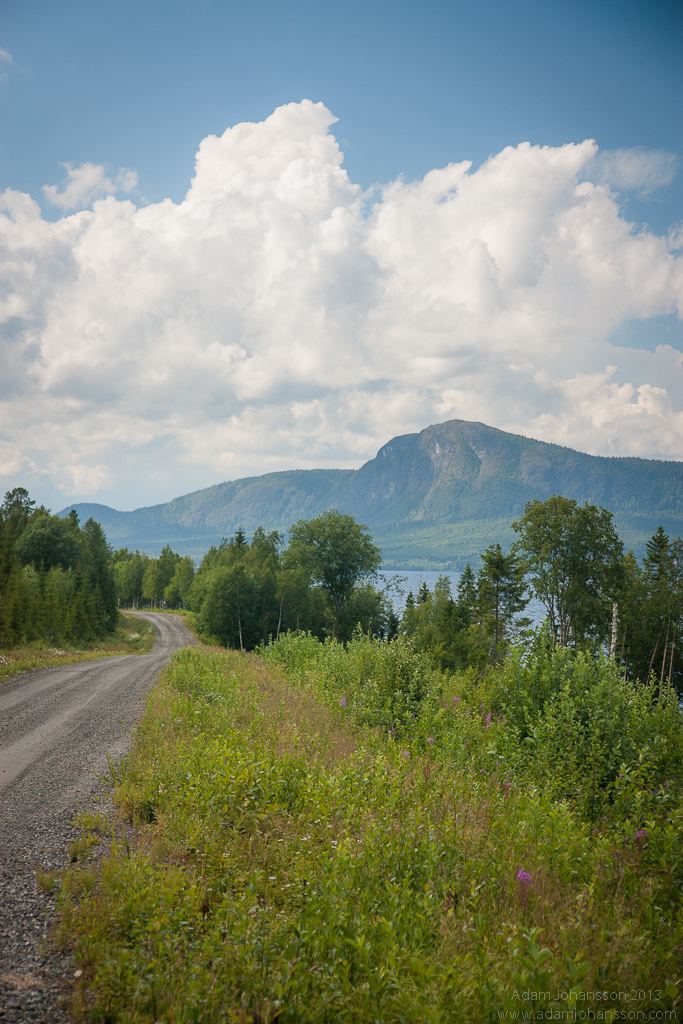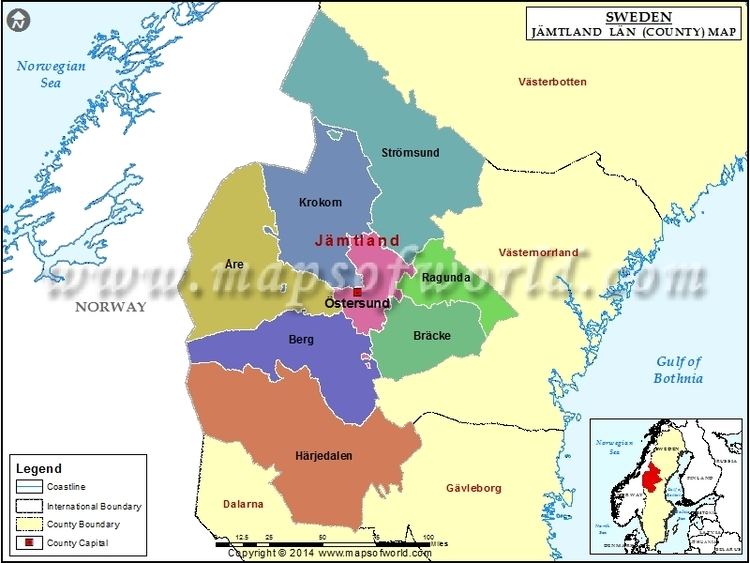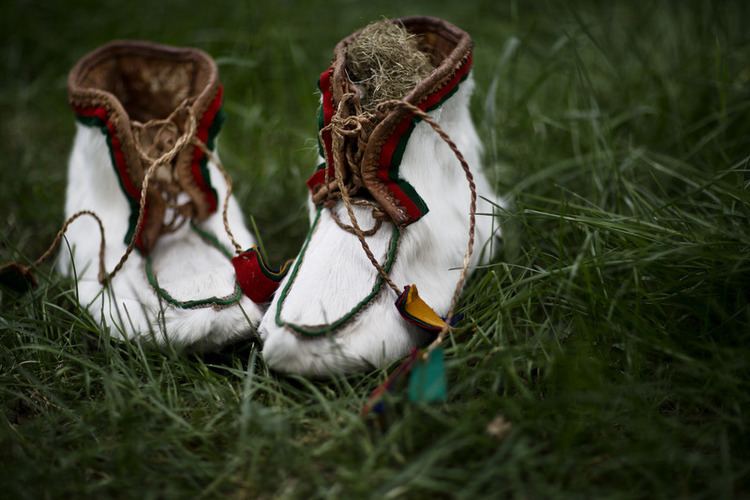Country Sweden Language spoken Swedish Area 34,009 km2 | ||
Destinations Ostersund, Are, Jarpen, Froson, Sveg | ||
Jamtland (Latin: Iemptia) or Jamtland is a historical province (landskap) in the center of Sweden in northern Europe. It borders to Harjedalen and Medelpad in the south, Angermanland in the east, Lapland in the north and Trondelag and Norway in the west. Jamtland covers an area of 34,009 square kilometres, 8.3% of Swedens total area and is the second largest province in Sweden. It has a population of 112,717, the majority of whom live in Storsjobygden, the area surrounding lake Storsjon. Ostersund is Jamtlands only city and is the 24th most populous city in Sweden.
Contents
Map of Jamtland
Jamtland was originally an autonomous peasant republic, its own nation with its own law, currency and parliament. However, Jamtland lacked a public administration and was thus best regarded as an anarchy, in its true meaning. Jamtland was conquered by Norway in 1178 and stayed Norwegian for over 450 years until it was ceded to Sweden in 1645. The province has since been Swedish for roughly 350 years, though the population did not gain Swedish citizenship until 1699. The provinces identity is manifested with the concept of a republic within the kingdom of Sweden, although this is only done semi-seriously.
Carl XVI Gustaf became the Duke of Jamtland after his christening, a nominal title he still retains.
Historically, socially and politically Jamtland has been a special territory between Norway and Sweden. This in itself is symbolized in the provinces coat of arms where Jamtland, the silver moose, is threatened from the east and from the west. During the unrest period in Jamtlands history (1563–1677) it shifted alignment between the two states no less than 13 times.
History

Some finds from the time before humans have been discovered in Jamtland, most notably the remains from a woolly mammoth in Pilgrimstad.

The first humans came to Jamtland from the west across the Keel approximately 7000-6000 BC, after the last ice age. The climate was at the time much warmer than today and trees such as oak were growing at the top of todays mountains. Several thousand archaeological remains have been located in the province, predominately near old camp-sites, beaches and lakes. The oldest settlement found is located at Foskvattnet, not far way from the so-called Fosna culture, this settlement has been dated to 6600 BC. In Jamtland the moose was the dominant prey, which is clearly shown on petroglyphs and rock paintings in for example Garde and Glosa. Jamtland has over 20,000 documented ancient monuments, the oldest one being an arrowhead found in Aflo near Kaxas in Offerdal parish possibly older than 8,000 years, which would make it one of the oldest stone age finds in all of Sweden.
Rock paintings found in Jamtland often collocates with various trapping pits and well over 10,000 pits used for hunting have been located, which is much more than any other Scandinavian region. Trapping or hunting pits were placed in areas in close proximity of the hunted animal in question, usually in known places where the animals moved. Because of this there are several places where pits have been dug separately in lines stretching on for miles throughout the landscape. Several place names in Jamtland still display the significance these pits had to the tribes.
A Jamtish Neolithic culture emerged during late Roman Iron Age in Storsjobygden, although the hunter-gatherers had come in contact with this lifestyle long before they settled down themselves. Since the hunts were rich and successful in Jamtland, it took a long time before a change occurred.
The Neolithic revolution happened quickly once initiated since the Tronders had been farmers for a long time and some of the Jamts had already begun herding. The Jamtish farmers grew first and foremost barley, although palynological study also show hemp. At the end of the 4th century a fortress, Mjalleborgen, was established on Froson to control the iron production and trade that took place. At the same time Kurgans starts appearing in the Jamtish landscape, just like in Bertnem in Trondelag and Hogom in Medelpad. The western influence from Trondelag through Jamtland to Norrland was at the time extensive.
The expansion of settlement was somewhat halted in the 7th century and Mjalleborgen was abandoned in the 8th century. A human migration occurred at the same time and the people concentrated themselves around Storsjon with villages such as Froson, Brunflo, Rodon, Hackas, Lockne and Nas being larger communities. Storsjobygden became an oasis in the middle of the Scandinavian inland, surrounded by dense forest. Horses were the only reliable mean of communications and a necessity.
During the viking age, the settlement in the province grew. This confirms the sagas written by Snorri Sturluson, where he narrates about the Vikings who fled from Harald Fairhair and Norway and took residence in Jamtland, just like many Norwegians at the same time fled and colonized Iceland. When a climate change (which later resulted in the Medieval Warm Period) took place, Froson acquired the position as regional centre. The warmer climate made the agriculture flourish, the stock-raising and the special inland Scandinavian herding or "livestock drifting", buforing, was developed further. This is especially true for the southern parts of Jamtland when the so-called "fell cow" was introduced. The hunt for moose and other wild animals increased during this period. Religiously the Jamts had abandoned the indigenous Germanic tribal religion in favour of the Norse faith. In religious practice, Jamtland was dominated by the older Vanir gods (Freyr, Njord, Ullr etc.), although the AEsirs were also worshiped.
As the population continued to grow, the Jamts established an Thing (assembly), just like other Germanic tribes. Jamtamot came into existence shortly after the worlds oldest parliament, the Icelandic Althing, was instituted in 930 CE. Jamtamot is unique in Scandinavia since it is the only one referred to as mot (a Gothic word) instead of þing, although they have the same meaning.
Physical geography

Jamtland is a large land-locked province in the heart of the Scandinavian peninsula in northern Europe. Jamtland stretches 315 kilometers in north-south direction and 250 kilometers in east-west direction and is equal in size with e.g. Ireland. Jamtlands western border is made out by Kolen which stretches throughout the province from north to south with branches into the landscapes southeastern parts. The fell massif is broken at some places by large valleys stretching all the way to the Norwegian Sea. These valleys have been used for centuries as paths connecting Jamtland to the west. The valleys were particularly heavily used during pilgrimages to Nidaros, the fourth most visited pilgrimage site during the medieval period. In fact no less than three pilgrim roads went through Jamtland.
The entire province is more or less a highland region with the highest peak being Storsylen, a peak in the Sylan mountain range with an altitude of 1 728 meters above sea level. Though this is not the highest peak in the mountain range, since that peak is in fact located on the other side of the border. Another large peak in Jamtland worthy of mention is Areskutan (1 420 meters above sea level). The lowest point in the province is as low as 35 meters above sea level and is located in the eastern part of Jamtland.
Approximately 8 per cent of Jamtlands area is covered by water and the province has two larger streams, Ljungan and Indalsalven (also known as Jamtlandsalven). Both of which emanates from the Scandinavian Mountains and drains several lakes on their way eastwards to lower altitudes.
Economy
The first humans came to Jamtland after the last ice age and later switched to a more agricultural lifestyle. Though the agriculture could not sustain the population so it was combined with a great deal of trading, hunting and iron production. When the rise of industrialism begun, Jamtland was one of the few Swedish regions that never became fully industrialized. Instead Jamtland supplied the Norrlandic coast with raw materials, mainly lumber. The focus in Jamtlands economy was directed towards tourism after the construction of the railroad, starting with the "clean air tourists" who came to experience the fresh air, to see the snow clad fells, the waterfalls and the natural environment. Today the tourism in Jamtland is dominated by winter sports and especially alpine skiing in various facilities in Are, Bydalen, Storlien, Klovsjo, etc.
Culture

The culture of Jamtland has been greatly affected by the fact that Jamtlands never had an upper class, since the population have mostly consisted of free sovereign farmers with wide connections and a strong regional identity. This has been the case for many generations. When Christian IV of Denmark punished the Jamts severely after having sworn the Swedish king their allegiance (see above) by turning them into tenant farmers and abolished their seal, he told them to stay put on their farms. They did not heed this call but instead sought help from their own organized advisors and "the lands defense", an insolence that further outraged the Danish king. Jamtland started out free and remained autonomous during its time as a Norwegian dependency. Because of Jamtlands historical background the local culture shows great similarities with the Norwegian farm culture.

Today, the history of Jamtland is exhibited in the regional museum Jamtli in Ostersund. The museum consists of an open-air section with historical buildings, as well as an indoor museum which houses exhibitions about the regions cultural history, from the stone age until modern times. Local history has been very popular in Jamtland for over 100 years, due to the extensive cultural home ground movement that emerged in the late 19th and early 20th century. The movement founded Jamtli to preserve the cultural heritage.
Cuisine

Much of Jamtlands cuisine is remnant from the herding stage. Just like other Scandinavians, it is common among Jamts to drink milk throughout their entire life. There are many different types of Jamtish dairy products, especially cheese, since it was by far the easiest way to conserve milk. Mesost is particularly associated with Jamtland and also e.g. a local variant of cottage cheese called grynost. In Jamtland there are several small dairies in the villages, most famous is the one in Skarvangen. Other products associated with Jamtland are the soft whey butter, long fil, kjesfil, flautgrot "cream porridge", tunnbrod, a version of palt called kams, klobb etc.

The ancient practice of brewing Julol (yule beer) persists even today with the microbrewery Jamtlands Bryggeri in Pilgrimstad.
Local projects such as the internet portal Food of Jamtland and the trading mark Smakriket Jamtland (the "taste realm" Jamtland) are two major contributors in marketing, preserving and developing the cuisine of Jamtland.
Some of the newest merchandises in Jamtland are a sparkling wine made of birch sap and a sausage called Jamtlandsfalu, wilderness juice, the snaps kallsup and tunnbrod chips.
